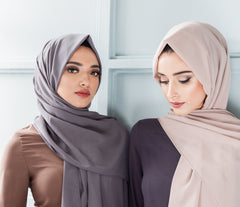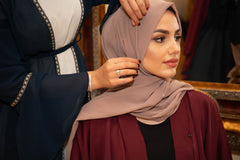How to wear a Hijab
What is a Hijab?
The term 'Hijab' doesn't actually refer to the scarf that Sisters beautifully drape around to cover their hair! Hijab from arabic to english actually translates to a 'partitioning' or a 'curtain' between ones modesty and the outside world. Interestingly the Hijab doesn't just relate to females but males too! In Islam dressing modestly doesn't just refine itself to women.
Hijabs in the UK can be purchased in Islamic clothing UK or abayas UK.
Now over time, the Hijab has taken a different definition and most of us when we hear it, take it as the a name for a scarf or headscarf that our lovely muslim sisters wear.
Wearing a veil that looks like a hijab was once practiced by Muslim, Jewish, and Christian, but today, it’s mainly associated with Muslim women and it is one of the most visible signs that one is a Muslim.

Types of Hijab
There are many types of veils, depending on the political system, geographic location, ethnicity, interpretation of literature, and customs. The most common types include:
- The burqa – Covers the entire body leaving crotched eye openings. It is mostly found in Pashtun Afghanistan.
- The niqab – Covers the head and the face but exposes the eyes.
- The hijab – A headscarf which covers the upper neck and the head but exposes the whole face.
- Shalwar qamis – Worn by South Asian women and men regardless of the pants, knee-length tunic, and religious affiliation.
- The chador – It is a dark or black coat which covers the entire body and the head and is held with one’s hands. It is mostly worn in Iran.
These types of hijab can be found in luxury abaya online and modest Islamic clothing.
Why Muslim Women Wear the Hijab
The hijab is worn by Muslim women as it is a practice that is specific to Islamic religion and as a way to reconnect with their faith. Hijab does have it's cultural and societal differentiation for example in the western world the Turban style Hijab has become fashionable whereas this style would not be seen in the Middle East.
Some women say that a hijab gives them a sense of liberation and freedom from choosing clothing or dealing with a bad hair day! while others wear it because the community, their friends, and family members do it which asserts their sense of belonging.
Choosing the right Hijab to Wear
Before purchasing a Hijab, check out the best requirements on Muslim magazines and on the Internet such as plain abaya and abayas online UK. One of the main factors you should consider is that a hijab should be able to totally cover your hair and expose the face. When you go shopping, you will learn that there are different products and types of hijabs available. You will also learn how to do with hijabs that need pinning, wrapping, folding, require typing.



Select your hijab
Visit our hijab selection. Some type of hijabs comprise of a single fabric piece which may be triangular, oblong, and square. These hijabs are tied, wrapped and pinned to hold them. Others have fabric tubes which slip over their head, and they come in one and two-piece styles. This style is easy for beginners as they do not require pinning. Buy a hijab which has a neutral color or that matches your outfit. Avoid extreme bold designs and colours. Hijabs manufactured from natural fiber such as cotton and silk are more comfortable because these fabrics offer proper circulation of air.
Be elegant with Hijab
Wearing hijab can make you look elegant. Wear structured long jackets, wide-legged, swirling skirts, and bold tunics. Many clothing stores offer hijabs for formal and casual wear. Hijab should not be worn as a uniform and it is not mandatory to look elegant but avoid being overly colorful.
Wear hijab that allows you to be modest and active
If you love sports, get a hijab that is designed for athletic wear in a colour which matches the sports clothes. Besides, there are swimsuits available for women who love swimming at most clothing stores such as occasion abayas.
How to Wear Hijab in a simple style

- Place an underscarf on your head.
Wear a bandana or a bonnet on year head. They help put your hair steady.
- Spread your Shayla over your head.
The shayla should cover your underscarf completely. Scarves are sold in many places, including online specialty stores and Muslim stores. You can also make one from fabric by ensuring the material is opaque.
- Adjust the shayla such that one side is longer than the other.
The ends of the shyla should be on the front side of your body. If it is thin, ensure that you flatten it fully on your head. Besides, you can use a pin to connect your shayla’s sides under the neck to make sure the hijab is intact.
- Make use of the longer side of the shayla
Hold the edge of the long side of the shayla with the hand and bring it towards the opposite shoulder and wrap it under your chin. Wrap it around the other end of you head and pin it.
- Wrap the short end under your chin
Tuck the shorter edge under the longer side and then pin it.
It is also possible to add more layers. To add a layer, wrap the shayla tighter give room for the extra layer. You can also match fabrics and colours if you want to look more elegant. Minimize the number layers during summer, particularly if you’ve a lot of hair.
Hijab without a pin
If you have snoozed your alarm too many times, and you are often late for work, you might find it hard to fiddle with the ball pins, as you try to put your hijab in place. The solution to this is taking a long rectangular scarf and wrap it round the head once, throw one end over the opposite shoulder, and you are good to go.
Conclusion
Modest dressing does not have to be boring! It can be stylish and trendy as you desire. When choosing the right hijab there are no restrictions when it comes to colours. You can select the ones you love and always go for light and pleasant colors because they attract less heat. Also, try to choose materials that are made from silk and cotton as they’ll not irritate your hair or skin.





Leave a comment